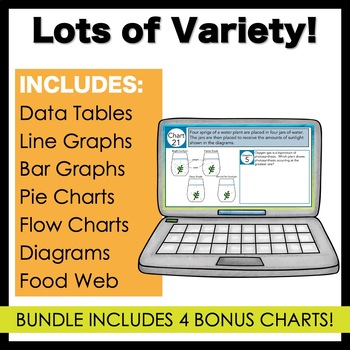Middle School Science Graphs Worksheets Print and Digital Bundle
- Zip
- Google Apps™

What educators are saying
Products in this Bundle (2)
Bonus
Description
Reading graphs is challenging! Teach your students to master comprehending and analyzing charts, graphs, and diagrams in just a few minutes a day! This mega pack gives students a graph or chart and five questions to help them comprehend and analyze it. Use with Google™ Slides or print them out.
If your students are like mine, they collected data well during a scientific investigation, but struggle to understand and interpret what the data means. I solved this problem by creating this digital No Prep! Print and Go! pack of 30 different data sets plus four bonus graphs only available in the bundle. Each data set includes five comprehension and analysis questions to help students practice this important skill. Each colorful slide includes a brief introduction to the data, a copy of the data and a large space to answer the question. There is one question per slide.
Use them as a warm-up, bell ringer, in class assignment, or as homework! Answering just one question a day will take just the smallest bit of class time, but will keep their data analysis skills sharp! And, this pack will last almost a full year that way! 34 data sets x 5 questions = 170 days of day analysis! The bundle contains 4 exclusive data sets that are only available when you get the bundle.
WHAT'S INCLUDED
- 30 print and digital graphs, charts, data tables, and diagrams
- Covers Earth, life, physical, and general science
- 5 comprehension and data analysis questions for each chart/graph
- 4 Bonus graphs with 5 comprehension questions per chart/graph
- Directions for assigning and using Google Slides™
- Answer key (print only)
YOU MIGHT BE INTERESTED IN
- Check out the other products that are part of the No Prep! Print and Go! series. Just print and get your students started learning!
- My full line of science inquiry resources can be seen here!
- Click here for digital resources for your classroom.
Created by Classroom 214
Follow my store to hear about new resources and sales. New resources are 50% off for the first 24 hours!





